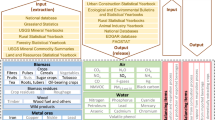Abstract
In this paper, both direct material input (DMI) and domestic processed output (DPO) of Jilin Province in 1990–2006 were calculated and then based on these two indexes, a dematerialization model was established. The main results are summarized as follows: (1) both direct material input and domestic processed output increase at a steady rate during 1990–2006, with average annual growth rates of 4.19% and 2.77%, respectively. (2) The average contribution rate of material input to economic growth is 44%, indicating that the economic growth is visibly extensive. (3) During the studied period, accumulative quantity of material input dematerialization is 11,543 × 104 t and quantity of waste dematerialization is 5,987 ×104 t. Moreover, dematerialization gaps are positive, suggesting that the potential of dematerialization has been well fulfilled. (4) In most years of the analyzed period, especially 2003–2006, the economic system of Jilin Province represents an unsustainable state. The accelerated economic growth relies mostly on excessive resources consumption after the Revitalization Strategy of Northeast China was launched.
Similar content being viewed by others
References
Cutler, J. C., & Matthias, R. (1998). Indicators of dematerialization and the materials intensity of use. Journal of Industrial Ecology, 2(3), 15–50. doi:10.1162/jiec.1998.2.3.15.
Environment Agency Japan (1992). Quality of the environment in Japan 1992. Tokyo, Japan: Environment Agency Japan.
Ester van der, V., Lauran van, O., & Igor, N. (2004). Dematerialization, not just a matter of weight. Journal of Industrial Ecology, 8(4), 121–137. doi:10.1162/1088198043630432.
EUROSTAT (2001). Economy-wide material flow accounts and derives indicators: A methodological guide. Luxebourg: EUROSTAT.
Farla, J. C. M., & Blok, K. (2000). Energy efficiency and structural change in the Netherlands, 1980–1995: Influence of energy efficiency, dematerialization and economic structure on national energy consumption. Journal of Industrial Ecology, 4(1), 93–117. doi:10.1162/108819800569203.
Gu, X. W., & Wang, Q. (2005). The environmental stress: Indicators and application [in Chinese]. Beijing, China: Metallurgical Industry Press.
Jordi, J. R., & Serrano, M. (2007). Income growth and atmospheric pollution in Spain: An input-output approach. Ecological Economics, 63(1), 230–242. doi:10.1016/j.ecolecon.2006.11.012.
Mukhopadhyay, K., & Forssell, O. (2005). An empirical investigation of air pollution from fossil fuel combustion and its impact on health in India during 1973–1974 to 1996–1997. Ecological Economics, 55(2), 235–250. doi:10.1016/j.ecolecon.2004.09.022.
Rutger, H., & van den Jeroen, B. (2002). Structural decomposition analysis of physical flows in the economy. Environmental and Resource Economics, 23(3), 357–378. doi:10.1023/A:1021234216845.
Schutz, H., & Bringezu, S. (1993). Major material flows in Germany. Fresenius Environmental Bulletin, 2(8), 443–448.
Steurer, A. (1992). Stoffstrombilanz Osterreich 1988. In IFF social ecology papers no. 26. Vienna, Austria: IFF Soziale Okologie.
Sun, J. (2003). Dematerialization in Finnish energy use, 1972–1996. Energy Economics, 25(1), 23–32. doi:10.1016/S0140-9883(02)00012-9.
Von Weizsaecker, E., Lovins, A. B., & Lovins, L. H. (1997). Factor four: Doubling wealth-halving resource use. London England: Earthscan Publications Limited.
Wier, M., & Hasler, B. (1999). Accounting for nitrogen in Denmark: A structural decomposition analysis. Ecological Economics, 30(2), 317–331. doi:10.1016/S0921-8009(99)00004-X.
Xu, M., Jia, X. P., Shi, L., & Zhang, T. Z. (2007). Accounting and analyzing material metabolism in the economic system of Liaoning Province. Resources Science, 29(5), 127–133 (in Chinese).
Zhang, Y. B., Xia, Z. X., Chen, X. G., & Peng, X. C. (2007). Dynamics of regional sustainable development based on material flow analysis. Resources Science, 29(6), 212–218 (in Chinese).
Author information
Authors and Affiliations
Corresponding author
Rights and permissions
About this article
Cite this article
Li, M., Zhang, H., Li, Z. et al. Economy-wide material input/output and dematerialization analysis of Jilin Province (China). Environ Monit Assess 165, 263–274 (2010). https://doi.org/10.1007/s10661-009-0943-4
Received:
Accepted:
Published:
Issue Date:
DOI: https://doi.org/10.1007/s10661-009-0943-4




